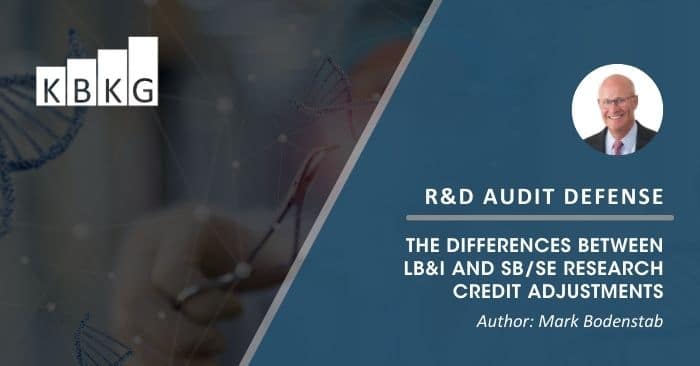Let’s assume a scenario where you filed for the credit for increasing research (“R&D credit”) and the Internal Revenue Service (“IRS”) selected your return for examination/audit. At the conclusion of the audit, the IRS has two basic options: a “no change” or a “disallowance.” As much as everyone would like to receive a “no change,” it is not unusual for a taxpayer to be advised of a partial or complete disallowance of their filed/claimed research credit.
Overall, there are similarities shared by the two examining divisions, the Large Business & International (LB&I) or Small Business/Small Enterprise (SB/SE), of the IRS. Both have a stated goal to resolve a disagreement at the lowest level and encourage meetings with the case manager to seek a resolution, but in practice, there are some subtle differences. It’s important to consider which examination jurisdiction has conducted the audit.
LB&I will provide a Form 5701 – Notice of Proposed Adjustments (“NOPA”) and an accompanying report explaining the adjustment (generally a Form – 886A). LB&I’s Guide for Quality Examinations is established in Section 4.46 of the Internal Revenue Manual (“IRM”). Specifically, Section 5 (revised December 13, 2018) focuses on Resolving the Examination. LB&I stresses meaningful discussions of issues throughout the examination process to encourage agreements on tax treatment. Ultimately, this openness can provide benefits to both sides of the examination, delivering better efficiency and resource allocation. It also can provide clarity to both parties in future cycles.
The Form 5701 is not mandatory in SB/SE (see IRM 4.10.7.5.6), and examiners in the Division generally issue a 30-day letter. SB/SE is subject to the procedures in IRM Part 4 Chapter 10 Section 7, Issue Resolution (January 10, 2018). It also encourages open communication between the examiner and the taxpayer, which should lead to a resolution. The examiner is supposed to discuss the progress of the audit and any proposed issues with the taxpayer and/or representative at frequent intervals during the examination. The IRM recommends face-to-face meetings, and telephone conferences are exceptions. A proposed adjustment should not be mailed to the taxpayer without a previous discussion between the examiner and the taxpayer. During these unusual times, however, some taxpayers feel disengaged from the process because they are receiving proposed adjustments with less than adequate discussion.
In a perfect scenario, such as envisioned in LB&I’s “Quality Exam Process” (“QEP”) which promotes communication and consistency in the exam process, you may agree with the examiner’s findings and accept the decision. Realistically that does not happen often enough, so you will likely need to formally disagree with the adjustment and begin to work on some form of resolution.
If there is a disagreement and a discussion with the examiner is fruitless, request a meeting with the manager. In SB/SE, an examiner should offer a conference with the immediate manager, and field managers are required to make contact in person or by telephone with the taxpayer or representative. In LB&I, meetings are a must. Further, a sound argument can be elevated upward through several layers of management. All examiners are responsible for apprising the taxpayer of their opportunity to participate in a Fast Track Settlement (“FTS”), as well as to explain the Appeals Process.
LB&I instituted the FTS program for its taxpayers in 2003. SB/SE implemented a pilot program for FTS in 2006, which was based on the LB&I concept. The pilot was extended several times, finally rolling out nationwide in 2013. If a case is approved for FTS, note that the examining division will still “own” the case. An Appeals Officer is merely assigned to mediate a (hopeful) resolution. The taxpayer and examiner must agree to the resolution.
If a resolution is not achieved through FTS, the next available route entails sending the case to Appeals. (Part 8 of the IRM describes the Appeals process.) Appeals operate separately from the examination divisions, and Exam and Appeals can only speak to each other with the taxpayer’s approval. It is one of the last opportunities to resolve an issue before any litigation takes place. Appeals do consider the hazards of litigation if there is uncertainty as to how the courts would apply the law. In practice, it does provide fair and impartial settlements, and despite the preparations required of both taxpayers and the exam, it does avoid expending resources in a protracted court battle. Any concession made just to eliminate court costs (a nuisance settlement) is not allowed. Be aware that Appeals personnel must address the degree of taxpayer cooperation in their Appeals Case Memos.
Finally, without achieving a satisfactory result, a taxpayer still maintains their right to proceed to a court-imposed solution. Suffice it to say, short of the litigation route, the IRS is more than familiar with the resolution process explained above. It is always a good idea to work with a partner with equivalent IRS experience to generate the best outcome following a proposed adjustment.
KBKG Provides Unique R&D Audit Defense Service
Did you claim the Research & Development (R&D) Tax Credit and are now under audit? Regardless of how you got here, we can help. With decades of research credit audit experience, we fully understand IRS audit techniques and procedures. Our firm can guide you through the audit process in the least amount of time while sustaining the maximum credit possible. » Learn more about our R&D audit defense service.
Download The Differences Between LB&I and SB/SE Research Credit Adjustments
About the Author
 Mark Bodenstab – Director
Mark Bodenstab – Director
New Hampshire
Mark Bodenstab is a Director of the Research & Development Tax Credit Services, operating out of New Hampshire. Mark brings knowledge of many aspects of R&D from his 20+ years in the private sector as well as 14 years with the Internal Revenue Service (IRS). He joined the IRS as a General Engineer to provide technical and valuation support in the examination of large corporate tax filings. He has experience in a wide range of engineering issues, including the complicated credit for increasing research. » Full Bio


